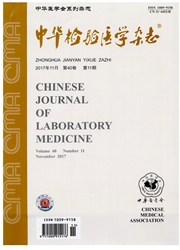

 中文摘要:
中文摘要:
目的探讨感染性疾病患者白假丝酵母菌分子分型和系统进化,并进行菌株生物膜表型分析。方法选择2006至2011年上海市公共卫生临床中心92例感染性疾病患者(病毒性肝炎、结核、HIV感染者)血液、穿刺液和黏膜等部位分离鉴定的104株白假丝酵母菌菌株,采用国际通用的多位点序列分型(MLST)进行克隆株的鉴定分型和进化研究。选用甲基四氮盐代谢实验(XTF)筛选强生物膜形成能力菌株。实验结果选用Kruskal—Wallistest非参数检验统计分析。结果104株白假丝酵母菌菌株共检测出63个二倍体基因型(DST),其中41(65.1%)个DST型在MIST数据库中未曾报道,同时发现8个新等位基因型。在这104株菌中,94.2%的菌株聚集在全球MLST数据库18个已知的进化枝中的14个分枝上,进化枝1中包含最多数量的菌株,占26.9%。41个新的DST型菌株中86%的菌株聚集在18个已知的进化枝中的11个进化枝上。生物膜形成能力试验共筛选出16株高生物膜形成能力菌株,菌株的生物膜形成能力在不同的生理解剖部位差异有统计学意义(H=18.23,P=0.0326),导管分离的菌株生物膜形成能力明显高于血液分离的菌株(Z=-72.20,P〈0.001)。白假丝酵母菌的分子分型与菌株的生物膜形成能力有相关性(H=10.01,P=0.0185)。结论遗传和表型分析结果显示感染性疾病患者白假丝酵母菌呈分散性分布,无明显的克隆传播流行的特点。菌株的分离部位、基因型与高生物膜表型相关。
 英文摘要:
英文摘要:
Objective To study the molecular epidemiology of C. albicans isolates in infectious disease patients and to explore biofihn phenotypic characterization responsible for biofilm formation in clinical strains. Methods A total of 104 hospital-acquired C. alibeans clinical isolates collected from sterile sites and mucosal lesions of 92 infectious disease patients (viral hepatitis, tuberculosis and AIDS ) in Shanghai Public Health Clinical Center were analyzed. MLST analysis was performed to identify their phylogenetic status. The capability of biofihu formation was measured by [ 2,3-his- (2-methoxy-4-nitro-5-sulphcnyl) -2H- tetrazolium-5-carboxanilide] XTT assay. The results were compared using Kruskal-Wallis test. Results MIST analysis identified 63 DSTs with a decentralized phylogeny among 104 C. albicans isolates, of which 41 DSTs (65.1%) had not been reported in the online MLST database. The Single Locus Sequence Query from the C. albicans database identified new alleles. MEGA6 analysis of the MLST data assigned the 104 isolates within 14 of the 18 known clades; among them the clade 1 contained the greatest proportion of isolates (26. 9% ). Of the 43 novel DSTs isolates, 37 (86.0%) clustered within 11 of the 18 known clades. 16 high biofilm formers were found from a total of 104 clinical isolates. The biofilm formation capabilities differed in strains isolated from different anatomical sites (H = 18.23, P = 0. 0326). Biofilm formation by blood-originated isolates was lower than that of catheter-originated isolates ( Z = - 72.20, P 〈 0. 001 ). Genotypes also affected the biofilm formation capability of the C. albicans isolates (H = 10. 01 ,P = 0. 0185). Conclusions A high level of diversity within C. albieans isolates. Microevlution clearly influences C. albieans genetic alterations upon environmental selection. The site of isolation and genotype associates with the biofilm formation capability.
 同期刊论文项目
同期刊论文项目
 同项目期刊论文
同项目期刊论文
 Genetic and phenotypic characterization of Candida albicans strains isolated from infectious disease
Genetic and phenotypic characterization of Candida albicans strains isolated from infectious disease Mechanisms of linezolid resistance in staphylococci and enterococci isolated from two teaching hospi
Mechanisms of linezolid resistance in staphylococci and enterococci isolated from two teaching hospi 期刊信息
期刊信息
